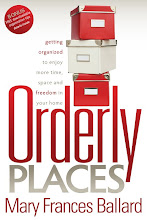It appears spring has arrived. In fact there were some hot days in April that had me thinking maybe we would jump from winter to summer. This month will probably be the last opportunity to take care of the
garage and/or attic before it is too hot to do it even early in the morning.
If you have been removing one bag of items per week as we suggested in January, then you are well on your way to having your other spaces organized. And if you have been eliminating an hour of electronics a week, you now have plenty of time to tackle these monumental storage areas.
Since the Garage is more convenient, let’s begin there. During the winter it often becomes a temporary dumping ground for items.
Take advantage of systems that will allow you to organize your items off the floor. For pennies or hundreds of dollars, you can invest in items that will work for you. Check out the home improvement stores for hooks or shelving units. Be sure to label bins and cardboard boxes used for storage.
Move out items you no longer need. Only things you continually use should be kept. Boxes of old magazines, newspapers, etc. should be recycled. Let’s face it. You didn’t have time to read them before and you won’t later on. There are too many new ideas coming at us everyday.
Update the garden tools and accessories. Remove rusted, broken or stained plant containers, stepping stones and other garden fixtures. Add outdoor furniture and children’s outside toys to the checklist.
Review the sporting equipment to see if it is still needed. Move on any you no longer use.
Plan ahead so you can make room for the car if you have not already done this. Your automobile is probably the second most expensive investment you have made so take care of it. Mark off a space for it on the floor. Identify a wall item or hang a string or chain from the ceiling as a marker for how far you should pull forward.
Attack the Attic. Unless you are storing items for another family member, the goal is to keep as little as possible in the attic. It is inconvenient to access and too hot or cold for many items to be kept safely. In addition, you must take care to prevent invasion by critters.
For safety add lighting and secure floor boards in areas you must use.
For items you must keep, create zones for the types of items you are storing. Holiday items can be labeled and stored together. Take care to cover wood furnishings with sheets or blankets. Upholstered furniture should not be stored in the attic for many reasons.
The attic is not suitable for candles, photographs, soft plastics such as in dolls, electronic media such as tapes, and many fabrics.
If there are many items left after sorting, purging and cleaning the attic space, it is a good idea to create a map of where items are located. This will save much time when it is necessary to recover them.
If you planned a yard sale, do it before the weather gets too hot to stay outside all day. Now is the time to unload all the things you removed during the past few months and from the garage and attic this month. Consider donating any items that do not sell. If you cannot part with them, store them together and label them for a future sale. Do not let them take up valuable space you use everyday.
A few other reminders for May:
Change the a/c filter and have a routine inspection of all its components before the scorching days of summer arrive. Clean ceiling fan blades and give other fans an inspection.
Clean the carpets and floors. They were used and abused all winter and deserve a thorough cleaning. If piles of clutter or stacks of items are on them, consider moving the items to shelving, cabinets or tables. Floors are easier to keep clean when only furniture is on them.
Plant flowers or hang flowering baskets. I vote for perennials although many do not continue to bloom through the summer months. Since they will come back each year, it saves time and money. Then plan on spending some time outside enjoying them before the bugs and scorching heat arrive!


